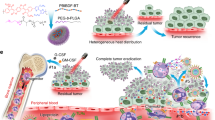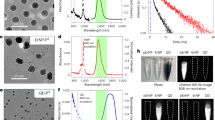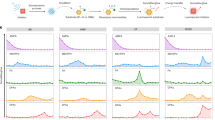Abstract
Conventional antibiotics used for treating tuberculosis (TB) suffer from drug resistance and multiple complications. Here we propose a lesion–pathogen dual-targeting strategy for the management of TB by coating Mycobacterium-stimulated macrophage membranes onto polymeric cores encapsulated with an aggregation-induced emission photothermal agent that is excitable with a 1,064 nm laser. The coated nanoparticles carry specific receptors for Mycobacterium tuberculosis, which enables them to target tuberculous granulomas and internal M. tuberculosis simultaneously. In a mouse model of TB, intravenously injected nanoparticles image individual granulomas in situ in the lungs via signal emission in the near-infrared region IIb, with an imaging resolution much higher than that of clinical computed tomography. With 1,064 nm laser irradiation from outside the thoracic cavity, the photothermal effect generated by these nanoparticles eradicates the targeted M. tuberculosis and alleviates pathological damage and excessive inflammation in the lungs, resulting in a better therapeutic efficacy compared with a combination of first-line antibiotics. This precise photothermal modality that uses dual-targeted imaging in the near-infrared region IIb demonstrates a theranostic strategy for TB management.
This is a preview of subscription content, access via your institution
Access options
Access Nature and 54 other Nature Portfolio journals
Get Nature+, our best-value online-access subscription
$29.99 / 30 days
cancel any time
Subscribe to this journal
Receive 12 print issues and online access
$259.00 per year
only $21.58 per issue
Buy this article
- Purchase on Springer Link
- Instant access to full article PDF
Prices may be subject to local taxes which are calculated during checkout






Similar content being viewed by others

Data availability
The main data that support the findings of this study are available within the Article and its Supplementary Information. There are no data from third-party or publicly available datasets. The transcriptome raw data used in this paper were deposited in the NCBI Sequence Read Archive under accession number PRJNA1031148. Source data are provided with this paper. Other datasets generated during and/or analysed during the current study are available from the corresponding author upon reasonable request.
References
Global Tuberculosis Report 2022 (World Health Organization, 2022).
Kislitsyna, N. A. Comparative evaluation of rifampicin and isoniazid penetration into the pathological foci of the lungs in tuberculosis patients. Probl. Tuberk. 4, 55–57 (1985).
Khan, A. et al. Genetic variants and drug efficacy in tuberculosis: a step toward personalized therapy. Glob. Med. Genet. 9, 90–96 (2022).
Tostmann, A. et al. Antituberculosis drug-induced hepatotoxicity: concise up-to-date review. J. Gastroenterol. Hepatol. 23, 192–202 (2008).
Mane, S. R. et al. Increased bioavailability of rifampicin from stimuli-responsive smart nano carrier. ACS Appl. Mater. Interfaces 6, 16895–16902 (2014).
Mei, Q. et al. Formulation and in vitro characterization of rifampicin-loaded porous poly (ε-caprolactone) microspheres for sustained skeletal delivery. Drug Des. Devel. Ther. 12, 1533–1544 (2018).
Prabhu, P. et al. Mannose-conjugated chitosan nanoparticles for delivery of rifampicin to osteoarticular tuberculosis. Drug Deliv. Transl. Res. 11, 1509–1519 (2021).
Fenaroli, F. et al. Enhanced permeability and retention-like extravasation of nanoparticles from the vasculature into tuberculosis granulomas in zebrafish and mouse models. ACS Nano 12, 8646–8661 (2018).
Fang, R. H., Kroll, A. V., Gao, W. & Zhang, L. Cell membrane coating nanotechnology. Adv. Mater. 30, e1706759 (2018).
Engering, A. J. et al. The mannose receptor functions as a high capacity and broad specificity antigen receptor in human dendritic cells. Eur. J. Immunol. 27, 2417–2425 (1997).
Oldenborg, P. A. et al. Role of CD47 as a marker of self on red blood cells. Science 288, 2051–2054 (2000).
Rodriguez, P. L. et al. Minimal ‘self’ peptides that inhibit phagocytic clearance and enhance delivery of nanoparticles. Science 339, 971–975 (2013).
Stevens, M. M. & George, J. H. Exploring and engineering the cell surface interface. Science 310, 1135–1138 (2005).
Jafari, A., Nagheli, A., Foumani, A. A., Soltani, B. & Goswami, R. The role of metallic nanoparticles in inhibition of Mycobacterium tuberculosis and enhances phagosome maturation into the infected macrophage. Oman Med. J. 35, e194 (2020).
Maphasa, R. E., Meyer, M. & Dube, A. The macrophage response to Mycobacterium tuberculosis and opportunities for autophagy inducing nanomedicines for tuberculosis therapy. Front. Cell. Infect. Microbiol. 10, 618414 (2020).
Shi, L., Jiang, Q., Bushkin, Y., Subbian, S. & Tyagi, S. Biphasic dynamics of macrophage immunometabolism during Mycobacterium tuberculosis infection. mBio 10, e02550–18 (2019).
Fabriek, B. O. et al. The macrophage scavenger receptor CD163 functions as an innate immune sensor for bacteria. Blood 113, 887–892 (2009).
Matsubara, V. H. et al. Probiotic bacteria alter pattern-recognition receptor expression and cytokine profile in a human macrophage model challenged with Candida albicans and lipopolysaccharide. Front. Microbiol. 8, 2280 (2017).
Nicolaou, G., Goodall, A. H. & Erridge, C. Diverse bacteria promote macrophage foam cell formation via Toll-like receptor-dependent lipid body biosynthesis. J. Atheroscler. Thromb. 19, 137–148 (2012).
Bin, L. et al. Antiviral and anti-inflammatory treatment with multifunctional alveolar macrophage-like nanoparticles in a surrogate mouse model of COVID-19. Adv. Sci. (Weinh.) 8, 2003556 (2021).
Wu, H. H., Zhou, Y., Tabata, Y. & Gao, J. Q. Mesenchymal stem cell-based drug delivery strategy: from cells to biomimetic. J. Control. Release 294, 102–113 (2019).
Carlsson, F. et al. Host-detrimental role of Esx-1-mediated inflammasome activation in mycobacterial infection. PLoS Pathog. 6, e1000895 (2010).
Takaki, K., Davis, J. M., Winglee, K. & Ramakrishnan, L. Evaluation of the pathogenesis and treatment of Mycobacterium marinum infection in zebrafish. Nat. Protoc. 8, 1114–1124 (2013).
Kawai, T. & Akira, S. Toll-like receptors and their crosstalk with other innate receptors in infection and immunity. Immunity 34, 637–650 (2011).
Taylor, P. R. et al. Macrophage receptors and immune recognition. Annu. Rev. Immunol. 23, 901–944 (2005).
Wang, M. et al. A versatile 980 nm absorbing aggregation-induced emission luminogen for NIR-II imaging-guided synergistic photo-immunotherapy against advanced pancreatic cancer. Adv. Funct. Mater. 32, 2205371 (2022).
Tang, M. et al. Near-infrared excited orthogonal emissive upconversion nanoparticles for imaging-guided on-demand therapy. ACS Nano 13, 10405–10418 (2019).
Xu, C., Jiang, Y., Han, Y., Pu, K. & Zhang, R. A polymer multicellular nanoengager for synergistic NIR-II photothermal immunotherapy. Adv. Mater. 33, e2008061 (2021).
Goñi, F. M. The basic structure and dynamics of cell membranes: an update of the Singer–Nicolson model. Biochim. Biophys. Acta Biomembr. 1838, 1467–1476 (2022).
Ramasamy, M., Lee, S. S., Yi, D. K. & Kim, K. Magnetic, optical gold nanorods for recyclable photothermal ablation of bacteria. J. Mater. Chem. B 2, 981–988 (2014).
Yang, Y. et al. Supramolecular radical anions triggered by bacteria in situ for selective photothermal therapy. Angew. Chem. Int. Ed. 56, 16239–16242 (2017).
Zhang, J. et al. Photothermal lysis of pathogenic bacteria by platinum nanodots decorated gold nanorods under near infrared irradiation. J. Hazard. Mater. 342, 121–130 (2018).
Hessel, C. M. et al. Copper selenide nanocrystals for photothermal therapy. Nano Lett. 11, 2560–2566 (2011).
Li, Y. et al. Novel NIR-II organic fluorophores for bioimaging beyond 1550 nm. Chem. Sci. 11, 2621–2626 (2020).
Wang, J. et al. Brain-targeted aggregation-induced-emission nanoparticles with near-infrared imaging at 1550 nm boosts orthotopic glioblastoma theranostics. Adv. Mater. 34, e2106082 (2022).
Liu, S. et al. Incorporation of planar blocks into twisted skeletons: boosting brightness of fluorophores for bioimaging beyond 1500 nanometer. ACS Nano 14, 14228–14239 (2020).
Liu, Y. et al. One-dimensional Fe2P acts as a Fenton agent in response to NIR II light and ultrasound for deep tumor synergetic theranostics. Angew. Chem. Int. Ed. 58, 2407–2412 (2019).
Miao, W. et al. A versatile 980 nm absorbing aggregation-induced emission luminogen for NIR-II imaging-guided synergistic photo-immunotherapy against advanced pancreatic cancer. Adv. Funct. Mater. 32, 2203571 (2022).
Yamamoto, T., Takiwaki, H., Arase, S. & Ohshima, H. Derivation and clinical application of special imaging by means of digital cameras and ImageJ freeware for quantification of erythema and pigmentation. Skin Res. Technol. 14, 26–34 (2008).
Mitteer, D. R., Greer, B. D., Fisher, W. W. & Cohrs, V. L. Teaching behavior technicians to create publication-quality, single-case design graphs in GraphPad prism 7. J. Appl. Behav. Anal. 51, 998–1010 (2018).
Acknowledgements
This research was funded by the National Key Research and Development Program of China (2021YFC2302200, Y.L.), the National Natural Science Foundation of China (82322042, 82272248 and 81972019, Y.L.; 82102360, Y.W.), the China Postdoctoral Science Foundation (2022M720730, B.L.), the Natural Science Foundation of Guangdong Province for Distinguished Young Scholars (2022B1515020089, Y.L.), the Basic and Applied Basic Research Foundation of Guangdong Province (2021A1515110209 and 2022A1515140080, B.L.; 2020A1515110529, Y.W.), the Comprehensive Research Project of the National Natural Science Foundation of China (82241059, J. Zheng), the Zhongnanshan Medical Foundation of Guangdong Province (ZNSA-2021012, Y.L.) and the Training project of the National Science Foundation for Outstanding/Distinguished Young Scholars of Southern Medical University (C620PF0217, Y.L.).
Author information
Authors and Affiliations
Contributions
B.L., W.W., L.Z., Y.W. and Y.L. designed the research. B.L., W.W., L.Z., Y.W., X.L., D.Y., Q.G., Y.Y., J. Zhang, Y.F., J. Zheng, B.S., J.W. and H.W. performed the research. D.W. and B.Z.T. provided professional support for animal studies. All authors analysed and interpreted the data. B.L., W.W., L.Z. and Y.W. wrote the paper.
Corresponding authors
Ethics declarations
Competing interests
The authors declare no competing interests.
Peer review
Peer review information
Nature Nanotechnology thanks the anonymous reviewers for their contribution to the peer review of this work.
Additional information
Publisher’s note Springer Nature remains neutral with regard to jurisdictional claims in published maps and institutional affiliations.
Supplementary information
Supplementary Information
Supplementary Figs. 1–37, Table 1 and Discussions.
Supplementary Video 1
Time-dependent NIR-IIb imaging of a mouse with TB in a supine position after intravenous injection of BBTD@PM NPs.
Supplementary Data 1
Statistical source data for Supplementary Figs. 1, 2, 7, 12–14, 16–20, 22, 24 and 32–35.
Supplementary Data 2
ChemDraw file for the synthetic route to TPE-BT-BBTD.
Source data
Source Data Fig. 2
Unprocessed western blots.
Source Data Fig. 2
Statistical source data.
Source Data Fig. 3
Unprocessed western blots.
Source Data Fig. 3
Statistical source data.
Source Data Fig. 4
Statistical source data.
Source Data Fig. 5
Statistical source data.
Source Data Fig. 6
Statistical source data.
Rights and permissions
Springer Nature or its licensor (e.g. a society or other partner) holds exclusive rights to this article under a publishing agreement with the author(s) or other rightsholder(s); author self-archiving of the accepted manuscript version of this article is solely governed by the terms of such publishing agreement and applicable law.
About this article
Cite this article
Li, B., Wang, W., Zhao, L. et al. Photothermal therapy of tuberculosis using targeting pre-activated macrophage membrane-coated nanoparticles. Nat. Nanotechnol. (2024). https://doi.org/10.1038/s41565-024-01618-0
Received:
Accepted:
Published:
DOI: https://doi.org/10.1038/s41565-024-01618-0


